The nine most important things, you should know (about Stylo)
1. You should have a modern browser
Stylo is an Editor that only runs in a browser. It should be an up-to-date browser as for using the full HTML5 functionality. If you are using the latest versions of Chrome, Firefox and Edge, you should have no problems. Internet Explorer is supported from version 9 onwards.If you are working with older versions of browsers, have text browsers or JavaScript turned off, you will not be able to work with Stylo - more than an error message cannot be displayed in this case.

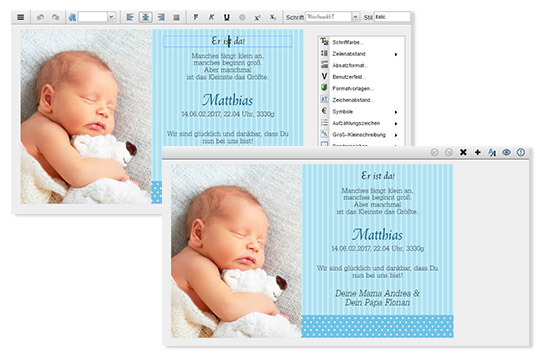
2. You think the toolbar can do a lot...
..., but then you haven’t gotten to know the so-called context menu of Stylo yet. This can be accessed via the right-hand mouse button (unless you have reconfigured your mouse) and has a lot of functions ready for you to use, so that you can customise the display according to your wishes.The mobile interface of Stylo comes with a differently designed toolbar which completely replaces the context menu. However, this simplified interface does not offer the complete range of functions. .
3. The power of the configurator
The configurator is:1. a program component of Stylo, with which rights groups can be set up and thus the functionality of Stylo can be restricted – perhaps so that no more than text input is possible. In addition, default values for font sizes, line thicknesses and the like can be set;
2. a person who has been given the right to use Stylo. You should be on good grounds with this person and carefully try to find out if he or she really likes the title “my configurator”.
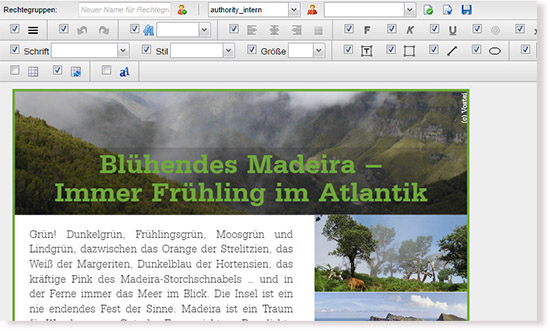
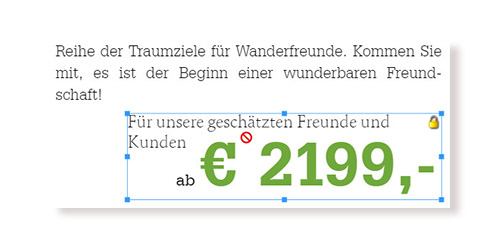
4. Freedom … is the only thing that counts
You may not be able to change objects in size or position in ads; sometimes you are not allowed to upload your images or change the design of the text. You should not assume that these are problems of the software, but are restrictions which the Ad Designer. Symbols, such as a lock point out these restrictions.5. Get the picture
There are 2 ways to get images into Stylo: you either use the upload functionality of Stylo or upload an image from your local device or the provider offers an image gallery and you can choose the desired image from a selection. In Stylo, you can then use the “cropping” function to get the image into the shape you want and give it a frame and decorative corners.In both cases, Stylo monitors the resolution of the images used - if an image is too large, then Stylo will use icons to indicate that this does not serve the quality of your ad. Worse still, it tells such problems on to the ad system, and by then the ad system is tapping you with error messages on the fingers.

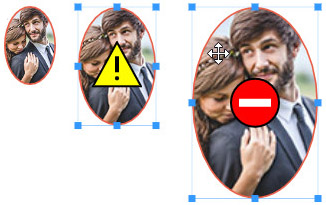

6. Check what you publish
The size of the ads is either text-dependent or fixed. If a display ad is growing, it can be in a completely free form, or it may be incremental growth, (for example, it grows in 5 mm increments). If the ad has a fixed height, your text can be distributed if there is less text than required, or if you have too much text, you will see an overset box. If you have too much text, then you should not ignore it – you know, Stylo tells on about things like this... (If you want to try this out, we have the right playground for you here.)Apropos »telling on«: The Editor can also be given a list of words that are banned from using in advertisements - a so-called »blacklist«.
7. It is written
You should know the following about the fonts used by Stylo: They are installed for Stylo on the server, so it doesn’t matter which fonts are available on your PC. Whatever fonts the Ad Designer chooses to have for his ad, will always be used. The fonts are placed in so-called pools and assigned in the ad templates. Which subsequently means, just because font 1 is available in template A, doesn’t mean it’s also available in template B.If you want to buy Stylo, please remember to buy the appropriate fonts. One option is the alfa fonts package.

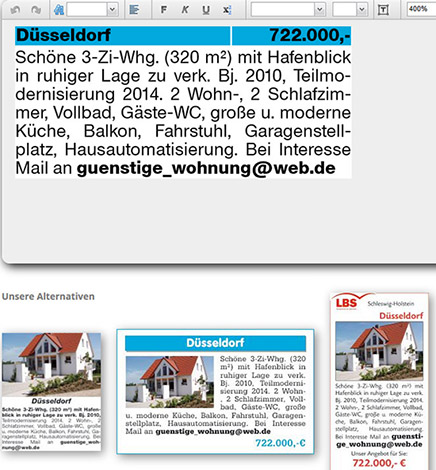
8. Simple but not lightweight
In Stylo there is no difference between “the templates are built here” and “the ads are filled with text and images here”. The Ad Designer works with the same Stylo as the user who produces the ads.Stylo has three additional modules and two interfaces. The configuration mode (the Configurator) has already been mentioned. In addition, there is a graphical interface for the administration of Stylo and the ServerRenderer, which is responsible for reformatting ads in the background and creating alternative ads for upselling.
The Stylo interface can be used as a desktop interface and on mobile devices.
